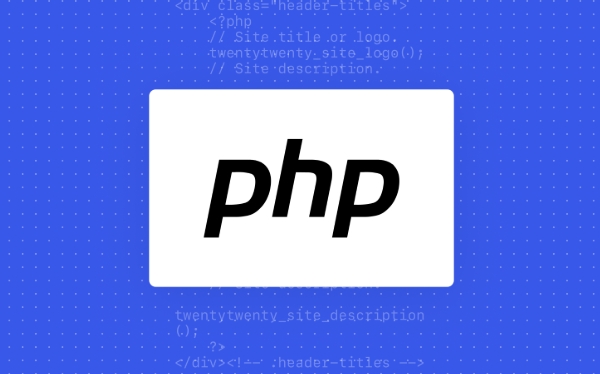Mastering User Input Validation with the PHP do-while Loop
Aug 01, 2025 am 06:37 AMPHP input validation using a do-while loop ensures that input prompts are executed at least once and requests are repeated when the input is invalid, suitable for command-line scripts or interactive processes. 1. When verifying the input of numeric values, the loop will continue to prompt until the user enters a number between 1 and 10. 2. When verifying a string (such as a mailbox), remove spaces through trim() and use filter_var() to check the validity of the format. 3. In the menu selection, make sure that the user enters valid options between 1-3. Key tips include: using trim() to clean input, reasonable type conversion, provide clear error information, and avoid infinite loops. This approach is suitable for CLI environments, but is usually replaced by frameworks or one-time validation in web forms. Therefore, when the logic of "ask first, check later" is needed, do-while is the best choice.

Validating user input is a fundamental task in web development, and PHP offers several ways to handle it effectively. One clean and reliable approach—especially when you need to ensure input is collected at least once and re-asked on invalid entries—is using the do-while loop . Unlike the regular while loop, the do-while guarantees that the input prompt runs at least once before checking the condition, making it ideal for input validation scenerios.

Here's how you can master user input validation in PHP using the do-while loop.
Why Use a do-while Loop for Input Validation?
The key advantage of do-while is its post-test nature. It executes the block first, then checks the condition. This is perfect when:

- You want to prompt the user for input at least once.
- You don't know in advance whether the input will be valid.
- You're building command-line scripts or simulating input flows (eg, in tutorials or CLI tools).
For example, asking a user to enter their age until a valid number is provided:
$age = null;
$valid = false;
do {
echo "Please enter your age: ";
$age = trim(fgets(STDIN)); // Read from command line
if (is_numeric($age) && $age > 0 && $age < 120) {
$valid = true;
} else {
echo "Invalid input. Age must be a number between 1 and 119.\n";
}
} while (!$valid);
echo "Thank you! Your age is: $age\n";This ensures the user is prompted at least once, and keeps looping until valid data is entered.

Common Use Cases and Patterns
1. Validating Numeric Input
Ensure the user enters a number within a specific range.
do {
echo "Enter a number between 1 and 10: ";
$input = (int)trim(fgets(STDIN));
$isValid = $input >= 1 && $input <= 10;
if (!$isValid) {
echo "Error: Number must be between 1 and 10.\n";
}
} while (!$isValid);2. Validating String Input (eg, Non-empty or Format)
Check for non-empty strings or match patterns like email.
$email = '';
do {
echo "Enter your email: ";
$email = trim(fgets(STDIN));
if (empty($email)) {
echo "Email cannot be empty.\n";
} elseif (!filter_var($email, FILTER_VALIDATE_EMAIL)) {
echo "Invalid email format.\n";
}
} while (empty($email) || !filter_var($email, FILTER_VALIDATE_EMAIL));
echo "Valid email entered: $email\n";3. Menu Selection Validation
Force the user to pick a valid menu option.
$choice = 0;
do {
echo "Main Menu:\n";
echo "1. Start Game\n";
echo "2. Load Game\n";
echo "3. Exit\n";
echo "Choose an option (1-3): ";
$choice = (int)trim(fgets(STDIN));
if ($choice < 1 || $choice > 3) {
echo "Invalid choice. Please select 1, 2, or 3.\n";
}
} while ($choice < 1 || $choice > 3);
echo "You selected option $choice.\n";Tips for Robust Validation
- Always sanitize input with
trim()to avoid accidental whitespace issues. - Use PHP's built-in filters like
filter_var()for emails, URLs, etc. - Cast input when needed (eg,
(int)for numbers) to avoid type confusion. - Provide clear error messages so users know what went wrong.
- Avoid infinite loops by ensuring the exit condition can be met.
Also, remember that fgets(STDIN) is typically used in CLI scripts . In web forms, you'd use $_POST or $_GET , but the do-while logic can still model validation flow during processing—though loops are less common there due to HTTP's stateless nature.
When Not to Use do-while
While powerful, do-while isn't always the best fit:
- In web forms, you usually validate once per request and redirect or re-render.
- If input might already be valid before the first prompt, a
whileloop or simpleifcheck may be cleaner. - Overusing loops in web contexts can lead to confusion—stick to form validation libraries or frameworks for complex cases.
Using the do-while loop for input validation in PHP gives you tight control in scenarios where repeated prompting is needed. It's especially useful in CLI tools, interactive scripts, or learning exercises.
Basically, if you need to ask first, check later , do-while is your go-to loop.
The above is the detailed content of Mastering User Input Validation with the PHP do-while Loop. For more information, please follow other related articles on the PHP Chinese website!

Hot AI Tools

Undress AI Tool
Undress images for free

Undresser.AI Undress
AI-powered app for creating realistic nude photos

AI Clothes Remover
Online AI tool for removing clothes from photos.

Clothoff.io
AI clothes remover

Video Face Swap
Swap faces in any video effortlessly with our completely free AI face swap tool!

Hot Article

Hot Tools

Notepad++7.3.1
Easy-to-use and free code editor

SublimeText3 Chinese version
Chinese version, very easy to use

Zend Studio 13.0.1
Powerful PHP integrated development environment

Dreamweaver CS6
Visual web development tools

SublimeText3 Mac version
God-level code editing software (SublimeText3)

Hot Topics
 PHP Variable Scope Explained
Jul 17, 2025 am 04:16 AM
PHP Variable Scope Explained
Jul 17, 2025 am 04:16 AM
Common problems and solutions for PHP variable scope include: 1. The global variable cannot be accessed within the function, and it needs to be passed in using the global keyword or parameter; 2. The static variable is declared with static, and it is only initialized once and the value is maintained between multiple calls; 3. Hyperglobal variables such as $_GET and $_POST can be used directly in any scope, but you need to pay attention to safe filtering; 4. Anonymous functions need to introduce parent scope variables through the use keyword, and when modifying external variables, you need to pass a reference. Mastering these rules can help avoid errors and improve code stability.
 How to handle File Uploads securely in PHP?
Jul 08, 2025 am 02:37 AM
How to handle File Uploads securely in PHP?
Jul 08, 2025 am 02:37 AM
To safely handle PHP file uploads, you need to verify the source and type, control the file name and path, set server restrictions, and process media files twice. 1. Verify the upload source to prevent CSRF through token and detect the real MIME type through finfo_file using whitelist control; 2. Rename the file to a random string and determine the extension to store it in a non-Web directory according to the detection type; 3. PHP configuration limits the upload size and temporary directory Nginx/Apache prohibits access to the upload directory; 4. The GD library resaves the pictures to clear potential malicious data.
 Commenting Out Code in PHP
Jul 18, 2025 am 04:57 AM
Commenting Out Code in PHP
Jul 18, 2025 am 04:57 AM
There are three common methods for PHP comment code: 1. Use // or # to block one line of code, and it is recommended to use //; 2. Use /.../ to wrap code blocks with multiple lines, which cannot be nested but can be crossed; 3. Combination skills comments such as using /if(){}/ to control logic blocks, or to improve efficiency with editor shortcut keys, you should pay attention to closing symbols and avoid nesting when using them.
 How Do Generators Work in PHP?
Jul 11, 2025 am 03:12 AM
How Do Generators Work in PHP?
Jul 11, 2025 am 03:12 AM
AgeneratorinPHPisamemory-efficientwaytoiterateoverlargedatasetsbyyieldingvaluesoneatatimeinsteadofreturningthemallatonce.1.Generatorsusetheyieldkeywordtoproducevaluesondemand,reducingmemoryusage.2.Theyareusefulforhandlingbigloops,readinglargefiles,or
 Tips for Writing PHP Comments
Jul 18, 2025 am 04:51 AM
Tips for Writing PHP Comments
Jul 18, 2025 am 04:51 AM
The key to writing PHP comments is to clarify the purpose and specifications. Comments should explain "why" rather than "what was done", avoiding redundancy or too simplicity. 1. Use a unified format, such as docblock (/*/) for class and method descriptions to improve readability and tool compatibility; 2. Emphasize the reasons behind the logic, such as why JS jumps need to be output manually; 3. Add an overview description before complex code, describe the process in steps, and help understand the overall idea; 4. Use TODO and FIXME rationally to mark to-do items and problems to facilitate subsequent tracking and collaboration. Good annotations can reduce communication costs and improve code maintenance efficiency.
 Quick PHP Installation Tutorial
Jul 18, 2025 am 04:52 AM
Quick PHP Installation Tutorial
Jul 18, 2025 am 04:52 AM
ToinstallPHPquickly,useXAMPPonWindowsorHomebrewonmacOS.1.OnWindows,downloadandinstallXAMPP,selectcomponents,startApache,andplacefilesinhtdocs.2.Alternatively,manuallyinstallPHPfromphp.netandsetupaserverlikeApache.3.OnmacOS,installHomebrew,thenrun'bre
 Learning PHP: A Beginner's Guide
Jul 18, 2025 am 04:54 AM
Learning PHP: A Beginner's Guide
Jul 18, 2025 am 04:54 AM
TolearnPHPeffectively,startbysettingupalocalserverenvironmentusingtoolslikeXAMPPandacodeeditorlikeVSCode.1)InstallXAMPPforApache,MySQL,andPHP.2)Useacodeeditorforsyntaxsupport.3)TestyoursetupwithasimplePHPfile.Next,learnPHPbasicsincludingvariables,ech
 How to access a character in a string by index in PHP
Jul 12, 2025 am 03:15 AM
How to access a character in a string by index in PHP
Jul 12, 2025 am 03:15 AM
In PHP, you can use square brackets or curly braces to obtain string specific index characters, but square brackets are recommended; the index starts from 0, and the access outside the range returns a null value and cannot be assigned a value; mb_substr is required to handle multi-byte characters. For example: $str="hello";echo$str[0]; output h; and Chinese characters such as mb_substr($str,1,1) need to obtain the correct result; in actual applications, the length of the string should be checked before looping, dynamic strings need to be verified for validity, and multilingual projects recommend using multi-byte security functions uniformly.






